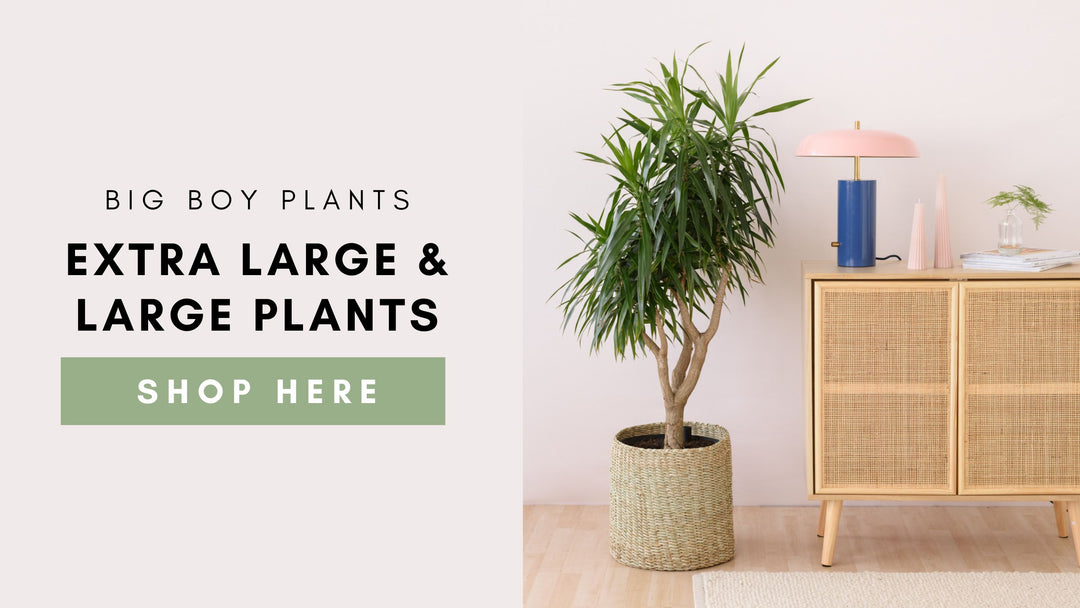Golden Pothos Care Instructions
Scientific Name: Epipremnum Aureus
Synonyms: Golden Pothos, Money Plant, Devil's Ivy, Ivy Arum, Scindapsus Aureus
The Golden Pothos is a staple in many plant collections and makes for the perfect beginner plant, not only because it is super easy-care but is able to withstand a variety of lighting conditions without hindering the plant's performance, however, avoid direct sun as this can lead to a washout looking and scorched plant.
The Golden Pothos (also called Devil's Ivy) will be happy to creep, trail or climb on any available surface, as it does in its natural habitat, proving to be a fantastic hanging specimen. And as an evergreen, it's sure to look good all year round.
Hailing from the Island of Mo'orea in the Society Islands, this tropical gem has low maintenance needs, however, to keep it truly thriving, provide with good humidity and regular watering.
Toxicity: Epipremnum Aureus is considered toxic when consumed.

Golden Pothos Common Symptoms
- Brown edges and leaf tips: Pothos can live happily in low humidity environments, but if brown tips and edging are persistent then your air is too dry. Rectify this by spritzing your indoor plant regularly or relocating to a room that has more moisture in the air.
- Solid green leaves: This is possibly due to the light being extremely low, as much as Golden Pothos can handle lower lighting conditions, very low light will cause your plant to lose its variegation. If your plant isn’t receiving enough light it will push out more plain green leaves to cope with the lack of lighting. Relocate to a brighter spot if this is the case.
- Bright yellow leaves: All pothos prefer to dry out between waterings but do not like to stay dry for long periods of time. Excessive yellowing of leaves is a sign that you may be allowing your plant to stay dry for too long. Adjust your frequency of watering and water again once at least 50% of your soil has dried out.
- Black/Brown leaves: Overwatering is diagnosed by black/browning leaves and rotting stems. If you are keeping your plant in a lower light situation be sure to keep an eye on your regularity of watering. Lower light will require less watering frequency. If you have black or brown leaves, adjust your watering and check that the soil is draining efficiently. As with under watering, allow at least 50% of your soil to dry out before watering again. Read for more on Identifying Overwatering vs Underwatering.
-
Pests: Golden Pothos are very rarely affected by pests making them easy to care for. However, if they are under any stress from any of the above symptoms they can be susceptible to common indoor plant pests such as mealybug and spider mite. Identify which pest you have as soon as noticed and try to remove it manually where possible. If you have a large infestation treat immediately with an organic pesticide such as Neem Oil or Pyrol.
Golden Pothos Care Instructions
- Origin: Society Islands and Parts of Asia
- Height: 2 meters indoors and 20 meters outdoors
- Light: Medium to Bright Indirect light.
- Water: Water approximately once a week allowing the top 50% of your soil to dry out before watering again. Adjust watering frequency in lower light conditions.
- Humidity: Low to Medium Humidity is sufficient. In the normal home environment, no adjustments to humidity should be required.
- Temperature: Can live happily in temperature ranges between 17°C and 30°C, but will tolerate lower temperatures for short periods of time.
- Soil: A free-draining organic all-purpose potting mix is sufficient.
- Fertilizer: For optimal growth, fertilize every 2 - 4 weeks with a well balanced organic fertilizer from Spring to Autumn.
- Repotting: Repotting should take place during Spring and Summer when your plant has become completely rootbound in its container or no new growth is taking place. Pot up in a pot no bigger than 5cm larger than its current container.
- Propagation: These are some of the easiest plants to propagate. Take stem cuttings that have at least 4 - 5 leaf nodes or are 10 - 15 cm in length. Strip off lower leaves, but be sure to leave some leaves near the growing tip. Place the leafless part of the stem in water and keep it on a bright filtered windowsill. Wait for roots to develop, once they have reached 3 - 5cm in length, pot up into a well-draining potting mix and keep evenly moist until your young cuttings start putting out new growth. Once this happens, treat in a similar manner as a mature plant.
If in stock, shop for Pothos here



